The Flower: Parts & Functions | Biology Class 11 - NEET PDF Download
| Table of contents |

|
| What is Flower? |

|
| About Four Whorls |

|
| Classification of Flower |

|
| Parts of Flower and Functions |

|
| Placentation |

|
Flowers are the reproductive structures found in angiosperms, which are the largest group of plants on Earth. Flowers play a vital role in the continuation of species. They also have cultural and economic significance. Flowers are used in various industries, including horticulture, perfume production, food and beverage industries, and traditional medicine.
What is Flower?
A Flower is the reproductive organ of a flowering plant (angiosperm). They are responsible for the production of seeds, which eventually develop into new plants.
- They are also a source of food for other living organisms. Flowers exhibit a wide variety of shapes, colors, sizes, and scents.
- Flower is a modified shoot that consists of four main whorls or parts: sepals, petals, stamens, and carpels.
 Whorls of Flower
Whorls of Flower
About Four Whorls
- Sepals: Complete flowers have sepals, which are the outermost whorl of protective, leaf-like structures that enclose and protect the developing flower bud.
- Petals: Complete flowers also have petals, which are the typically colorful, inner whorl of modified leaves. Petals are often involved in attracting pollinators to the flower.
- Stamens: The third whorl of a complete flower consists of stamens, which are the male reproductive organs. Each stamen comprises a filament and an anther. The anther produces pollen grains.
- Pistils or Carpel: The innermost whorl of a complete flower contains pistils, which are the female reproductive organs. A pistil typically consists of a stigma, style, and ovary. The stigma captures pollen, the style connects the stigma to the ovary, and the ovary contains ovules that develop into seeds.
Note: (a)Flower having both Male and Female reproductive part are called Bisexual Flower.
(b) Flower having either Male or Female reproductive part are called Unisexual Flower.
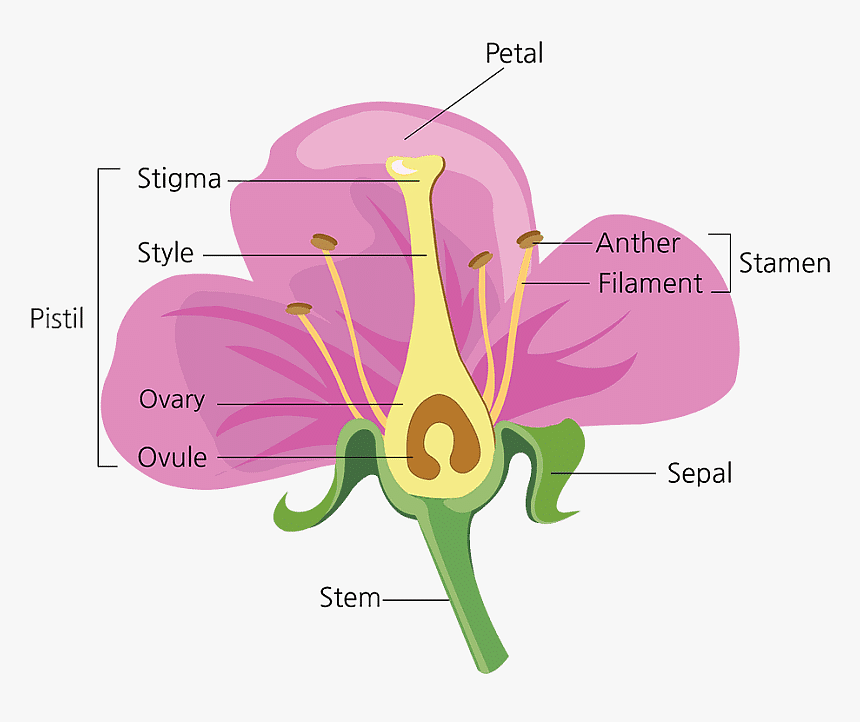 Parts of Flower
Parts of Flower
Classification of Flower

1. On the basis of Symmetry

Flowers can be classified based on their symmetry, which refers to the arrangement of floral organs or structures in relation to a central axis or plane.
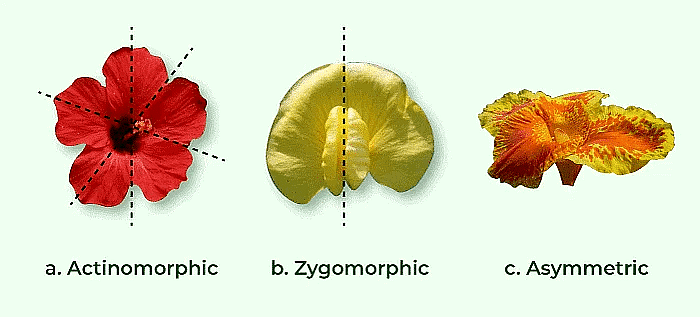
- There are 3 main types of symmetry observed in flowers are:
(a) Radial Symmetry (Actinomorphic): In radially symmetrical flowers, any plane passing through the center of the flower divides it into two equal halves. The floral organs are arranged in a circular or radial pattern around the central axis, and multiple planes of symmetry can be identified.
(b) Bilateral Symmetry (Zygomorphic): Flowers with bilateral symmetry can be divided into two equal halves by only one plane passing through the center.
(3) Asymmetric Symmetry: if flower cannot be divided into two similar halves by any vertical plane passing through the centre.
2. On basis of Position of Calyx, Corolla and Androecium with respect to Ovary
The classification is primarily determined by the relative position, attachment, and fusion of the floral organs on the receptacle.
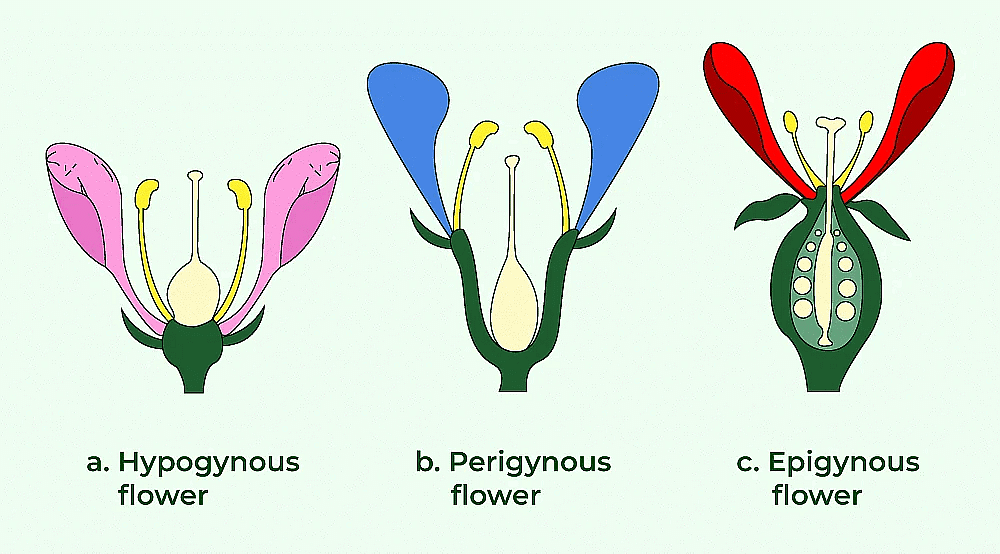
- There are 3 main types observed:
(a) Hypogynous Flowers: In hypogynous flowers, the floral organs (sepals, petals, stamens, and carpels) are attached to the receptacle (swollen end of the flower stalk where the floral parts of a flower are arranged. It is also known as thalamus). below the gynoecium.
The sepals and petals are positioned below the ovary. The stamens and carpels arise from above the level of the ovary. This arrangement is often seen in flowers with a superior ovary, where the ovary is located above the attachment point of other floral organs.
(b) Epigynous Flowers: In epigynous flowers, the floral organs are attached to the receptacle above the gynoecium. The sepals, petals, and stamens are positioned above the ovary, while the carpels arise from below the ovary.
The ovary is partially or completely enclosed within the receptacle. This arrangement is common in flowers with an inferior ovary, where the ovary is located below the attachment point of other floral organs.
(c) Perigynous Flowers: Perigynous flowers exhibit an intermediate arrangement, where the floral organs are attached to the rim or edge of a cup-like receptacle that surrounds the gynoecium.
3. On the basis of Floral Appendages
On the basis of floral appendages, flowers can be classified into different types. Floral appendages are the structures attached to the receptacle or thalamus of the flower, including sepals, petals, stamens, and carpels.
A Flower may be trimerous, tetramerous or pentamerous when the floral appendages are in multiple of 3, 4 or 5, respectively. Flowers with bracts-reduced leaf found at the base of the pedicel are called bracteate and those without bracts, ebracteate.
- Trimerous: Trimerous flowers have floral appendages arranged in multiples of three. This means that the flower has sepals, petals, stamens, or carpels in groups of three.
Example: Lilies - Tetramerous: Tetramerous flowers have floral appendages arranged in multiples of four. This means that the flower has sepals, petals, stamens, or carpels in groups of four.
Example: Jasmine - Pentamerous: Pentamerous flowers have floral appendages arranged in multiples of five. This means flower has sepals, petals, stamens, or carpel in groups of five.
Example: Hibiscus
Parts of Flower and Functions
1. Calyx
The calyx is a part of the flower and represents the outermost whorl of floral organs. It is typically green in color and consists of individual leaf-like structures called sepals. Sepals are usually green because they contain chlorophyll and resemble the leaves of the plant.
Types of Calyx
(a) Polysepalous Calyx: In this type, the sepals are separate and distinct from each other, and they are not fused or joined. Each sepal is free and can be easily distinguished.
Examples: roses, lilies, and sunflowers
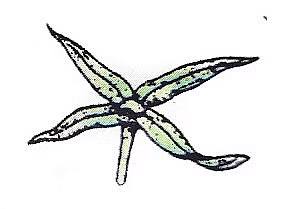 Polysepalous Calyx
Polysepalous Calyx
(b) Gamosepalous Calyx: In this type, the sepals are fused or joined together to some extent. They may be partially fused, forming a tube-like structure, or completely fused, forming a cup-like structure.
Examples: bellflowers (Campanula) and morning glories (Ipomoea).
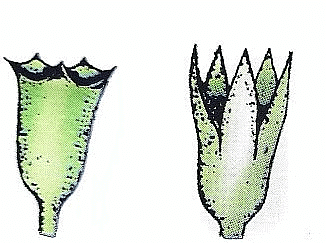 Gamosepalous Calyx
Gamosepalous Calyx
Functions of Calyx:
1. Protection: The calyx protects the flower in its bud stage. Sepals enclose and protect the developing flower bud, shielding it from physical damage, desiccation, and pests.
2. Support: The calyx provides structural support to the flower. It helps to hold the petals, stamens, and pistils in their proper position within the flower.
2. Corolla
The corolla is one of the main parts of a flower, located inside the calyx. It represents the second whorl of floral organs and is often the most visually attractive part of the flower. The corolla is composed of individual units called petals.
(i) Types of corolla
a: Polypetalous Corolla: In this type, the petals of the corolla are separate and distinct from each other. They are not fused or joined and can be easily distinguished.
Examples: Roses, Buttercups, and Lilies.
b: Gamopetalous Corolla: In this type, the petals of the corolla are fused or joined together to some extent. They may be partially fused, forming a tube-like structure, or completely fused, forming a cup-like or funnel-like structure.
Example: flowers of the pea family (Fabaceae)
(ii) Aestivation
Aestivation refers to the pattern in which the sepals or petals of a flower are arranged in relation to each other while they are in the bud stage.
There are several types of Aestivation, including the following:
a) Valvate Aestivation: In valvate aestivation, the sepals or petals in the bud are arranged in overlapping, but not touching, edges. Each sepal or petal occupies a position next to two others.
Example: Calotropis
b) Twisted Aestivation: In twisted aestivation, the sepals or petals in the bud are arranged in a twisted or spiral manner. Each sepal or petal overlaps with two others alternately, forming a spiral pattern.
Example: China rose, lady finger
c) Imbricate Aestivation: If the margins of sepals or petals overlap one another but not inany particular direction.
Example: Cassia and gulmohur
d) Vexillary or Papilionaceous Aestivation: In this type the largest petal overlaps the two lateral petals (wings) which in turn overlap the two smallest anterior petals.
Example: Pea , Bean flowers
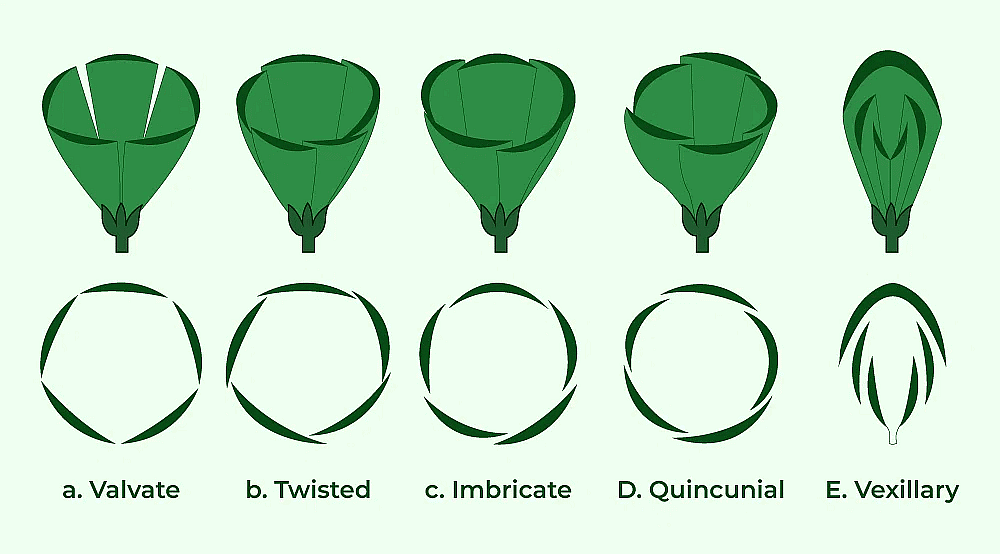
Functions of Corolla
1. Attraction: The corolla is responsible for attracting pollinators, such as insects or birds, to the flower. Petals often have vibrant colors, patterns, and sometimes fragrances that serve to attract pollinators. These attractive features help ensure the transfer of pollen from the stamens to the pistil.
2. Protection: While the primary function of the corolla is to attract pollinators, it may also provide some protection to the reproductive organs of the flower. The petals can act as a barrier, shielding the stamens and pistil from external factors such as wind or rain.
3. Androecium
Androecium is the male reproductive part of a flower, also known as the "whorl of stamens." It is responsible for producing and dispersing pollen, which contains the male gametes necessary for fertilization.
Components of Androecium:
- Filament: The filament is a slender stalk-like structure that supports the anther.
- Anther: The anther is the enlarged, sac-like structure located at the top of the filament. It contains pollen sacs or pollen grains, which produce and store pollen.
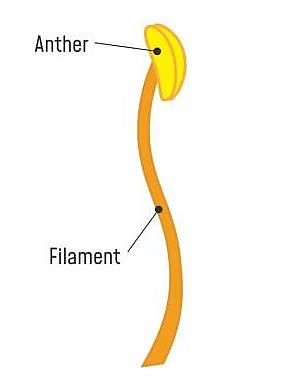 Stamen
Stamen
Types of Androecium
 Types Of Androecium
Types Of Androecium
(a) Monadelphous Androecium: In this type, the stamens are fused or joined together by their filaments into a single group or column. The fused stamens form a tube or cup-like structure around the female reproductive parts of the flower.
Examples: Onion family (Alliaceae) and the Hibiscus family (Malvaceae).
(b) Diadelphous Androecium
The stamens are arranged in two sets or groups. One set consists of a fused group of stamens, while the other set consists of free or separate stamens.
Example: A Pea Flower, there are nine stamens, with one set of fused stamens (9+1 arrangement) and a separate stamen.
(c) Polyadelphous Androecium
The stamens are fused or joined together in more than two groups. The fusion can occur in various ways, such as forming a tube, cup, or column.
Example: Flowers of the citrus family (Rutaceae) and the mallow family (Malvaceae) exhibit polyadelphous androecium.
(d) Epipetalous Androecium
The stamens are attached to the petals of the flower. They are either fused with the petals or attached to their bases.
Example: Flowers of the nightshade family (Solanaceae) and the lily family (Liliaceae).
(e) Epiphyllous Androecium
The Stamens are attached to perianth of the flower.
Example: Lily
Functions of Androecium
- Pollen Production: The main function of the androecium is to produce pollen. Pollen grains contain the male gametes (sperm cells) necessary for sexual reproduction.
Note: The pollen grains are produced in pollen-sacs. A sterile stamen is called staminode. - Sexual Reproduction: The androecium plays a crucial role in sexual reproduction by providing the male gametes required for fertilization.
4. Gynoecium
Gynoecium is the female reproductive part of a flower, also known as the "pistil." It is responsible for producing the female gametes (eggs) and facilitating the process of fertilization.
Components of Gynoecium
- Stigma: The stigma is the receptive part of the pistil located at the top. It is usually sticky or has specialized structures to capture pollen grains.
- Style: The style is a slender, elongated structure that connects the stigma to the ovary. It provides a pathway for the pollen grains to travel from the stigma to the ovary.
- Ovary: The ovary is the enlarged basal part of the pistil. It contains one or more ovules, which are the structures where the female gametes are produced. Each ovary bears one or more ovules attached to a flattened, cushion-like placenta
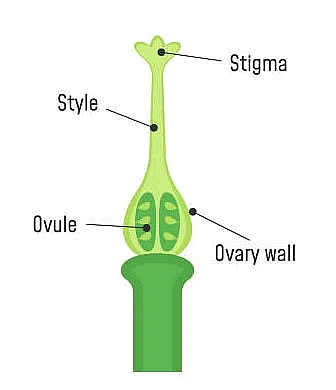
Types of Gynoecium
(a) Apocarpous Gynoecium:
Apocarpous refers to a type of gynoecium where the pistils or carpels of a flower are separate or not fused with each other. Each pistil in an apocarpous gynoecium has its own stigma, style, and ovary.
Example: Buttercup Family (Ranunculaceae), Rose Family (Rosaceae)
 Apocarpous Gynoecium
Apocarpous Gynoecium
(b) Syncarpous Gynoecium:
Syncarpous refers to a type of gynoecium where the pistils or carpels of a flower are fused or joined together to form a single structure.
Example: Mustard Family (Brassicaceae), Lily Family (Liliaceae)
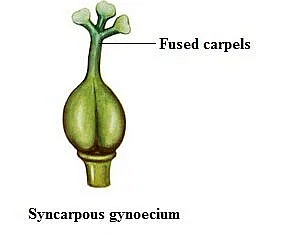
Placentation
Placentation is defined as the arrangement of the placenta in the ovary of a flower. The placenta connects the ovules with the wall of the ovary.
The types of Placentation are
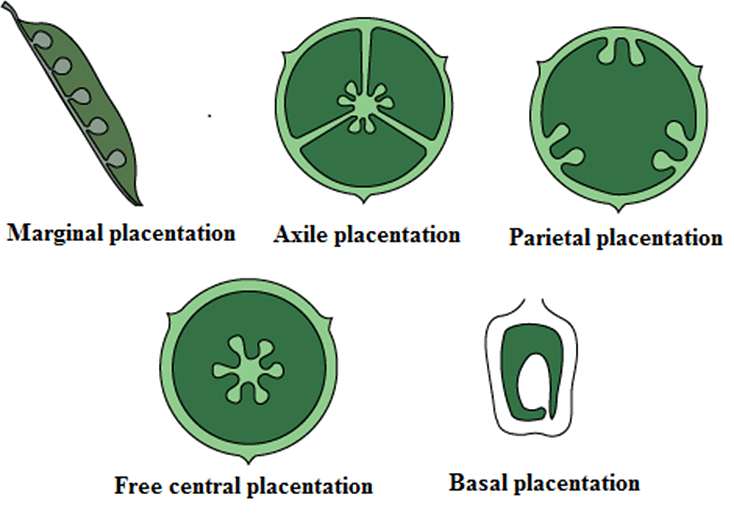
1. Marginal placentation: In marginal placentation, the placenta forms a ridge along the ventral suture of the ovary and the ovules develop on it making two separate rows. This type of placentation is found in pea plants.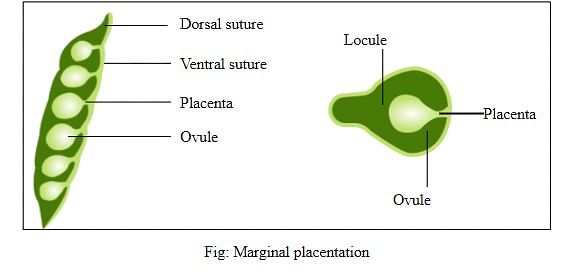
2. Parietal placentation: In parietal placentation, the ovules remain attached to the inner walls of the ovary. It is found in cucumber, etc.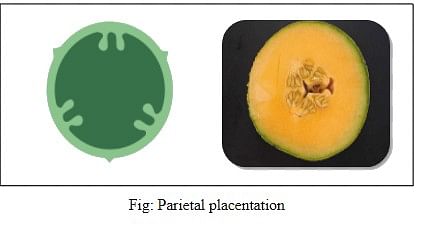
3. Axile placentation: In axile placentation, the placenta lies on a central axis and ovules are attached to it. The ovary is segmented by fibrous septa. It is found in China rose, lemon, and tomato.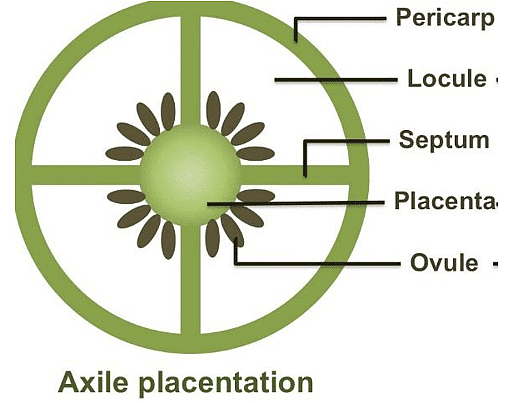
4. Basal placentation: In basal placentation, the placenta develops from its base and a single ovule is found attached to the base. It is found in the Asteraceae family that consists of marigold, sunflower, etc.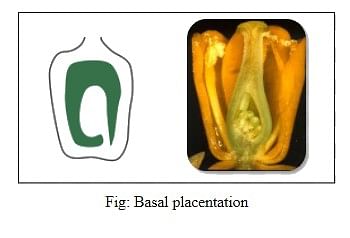
5. Free central placentation: In free central placentation, the ovules are present on the central axis. There is no formation of septa. This type of placentation is found in Dianthus and primrose.
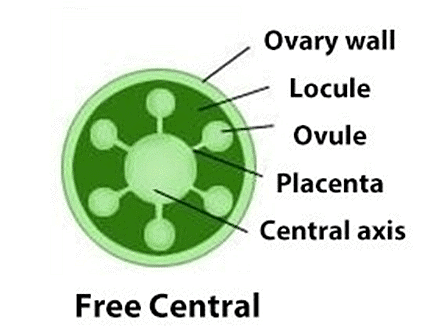
Note:
- The ovules inside a flower's ovary are attached via funiculi, the plant part equivalent to an umbilical cord in human beings. The part of the ovary where the funiculus attaches is known as the placenta.
- Placentation is meant for the transfer of nutrients, respiratory gases, and water from maternal tissue to the growing embryo, and also for the removal of waste from the embryo.
- Some plants have a special type of placentation known as Superficial placentation where the ovules develop over the entire inner surface of the carpels. It generally occurs in a multicarpellary ovary, e.g., Nymphaea.
|
181 videos|361 docs|148 tests
|
FAQs on The Flower: Parts & Functions - Biology Class 11 - NEET
| 1. What are the four whorls of a flower? |  |
| 2. How are flowers classified? |  |
| 3. What are the main parts of a flower and their functions? |  |
| 4. What is placentation in a flower? |  |
| 5. Why is understanding the parts and functions of a flower important? |  |

|
Explore Courses for NEET exam
|

|



















